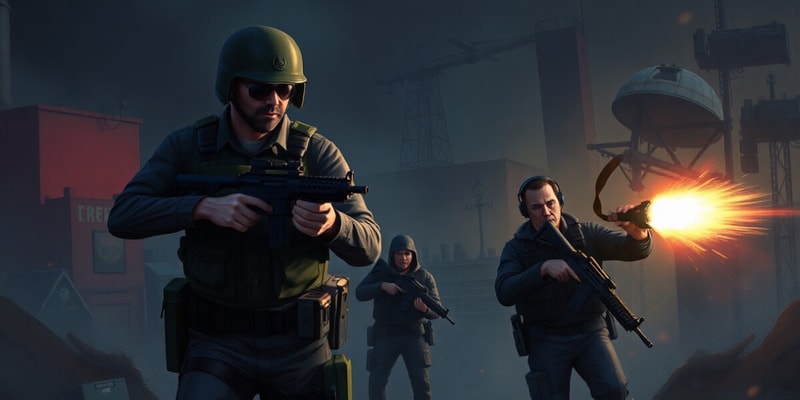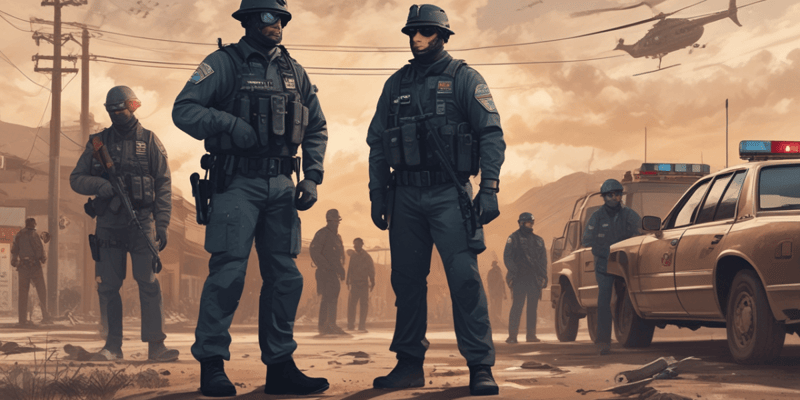Podcast Beta
Questions and Answers
What is a primary goal during a hostage situation?
In a hostage situation, what types of resources may agencies utilize?
Which of the following can be a hostage in a situation?
What factor does NOT influence the response to a hostage incident?
Signup and view all the answers
What should every officer be aware of when responding to any incident?
Signup and view all the answers
What is the first step to take when responding to a hostage situation?
Signup and view all the answers
Which action should be taken to ensure the safety of non-participants during a hostage situation?
Signup and view all the answers
What should you do if you are taken hostage?
Signup and view all the answers
Why is it important to restrict the movement of hostage takers?
Signup and view all the answers
What type of language should be avoided when communicating with a hostage taker?
Signup and view all the answers
What is a key aspect of gathering information during a hostage situation?
Signup and view all the answers
What should you do regarding your uniform if you are taken hostage?
Signup and view all the answers
In responding to a hostage situation, which of the following is NOT recommended?
Signup and view all the answers
Study Notes
Hostage Situations
- Hostage situations can occur without warning and involve holding one or more people against their will to achieve a specific goal.
- Anyone can be taken hostage, including inmates, civilians, officers, visitors, and staff.
- When responding to incidents or riots, you may be taken hostage.
Equipment
- Equipment used during hostage incidents varies by agency resources.
- Equipment may include restraints, chemical agents, weapons (lethal and non-lethal), emergency keys, and monitoring equipment (video records, closed-circuit television, cameras).
- Building blueprints and floor plans may be necessary.
- Communication devices, such as radios, megaphones, or cell phones, are also used.
- Equipment and technical assistance can vary between agencies and departments based on the incident's circumstances.
Standard Procedures
- The primary goal in a hostage situation is to resolve it without injury or loss of life.
- Response procedures vary based on agency resources, policies, and procedures.
- Steps taken during a hostage crisis change depending on the situation's circumstances, status, and severity.
- Specialized teams, such as tactical and negotiation teams, may be involved.
Standard Hostage Situation Procedures
- Notify your supervisor immediately, following the chain of command.
- Contain the subject(s) in the smallest area possible.
- Restrict the movement of the subject(s) while prioritizing safety.
- Gather information, including taking pictures or recording the situation.
- Move non-participants as far away from the hostage situation as possible.
- Provide assistance and support to specialized teams as needed.
Responding to Hostage Incidents
- When initially responding, contain the situation to prevent more hostages from being taken.
- Avoid agitating the hostage taker and instead build rapport and listen actively.
- Gather information about the location, names and number of hostages, names and number of hostage takers, injuries, weapons involved, and the hostage takers' demands.
- A staff member held hostage does not hold rank or authority in the incident.
If You Are Taken Hostage
- Cooperate with the hostage taker but do not enable them.
- Remember that staff will respond as soon as possible.
- Avoid using insults, trigger or hot words (words that may empower the hostage taker), such as "prisoner," "guns," or "police".
- Avoid being confrontational by keeping a low profile.
- Try to avoid giving up your uniform if possible.
- Keep your face down or avoid eye contact.
- Remain calm, rest when possible, and try to eat only food provided by the negotiating team.
- Cooperate fully with any response team member.
Studying That Suits You
Use AI to generate personalized quizzes and flashcards to suit your learning preferences.
Related Documents
Description
This quiz explores the dynamics of hostage situations, including the various roles individuals can play and the equipment typically used during such crises. Understand standard procedures and response strategies designed to manage these high-stakes incidents effectively.



